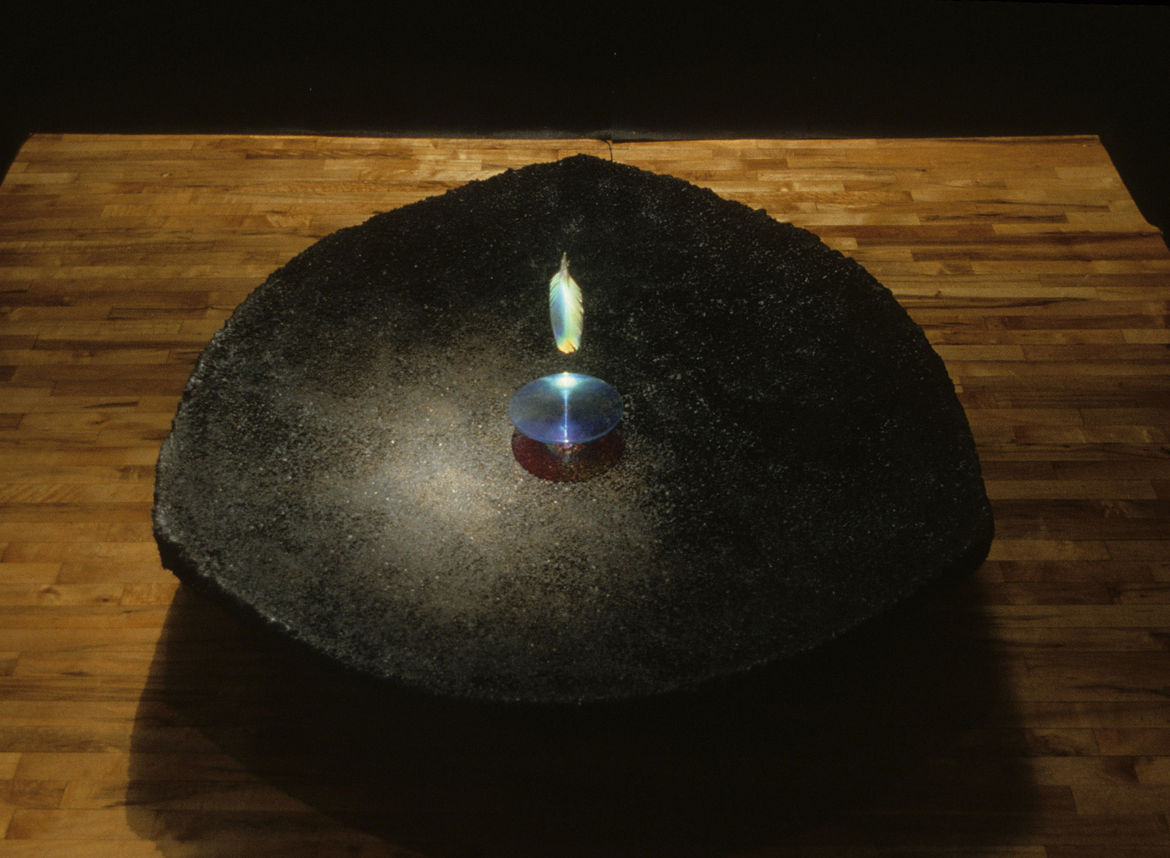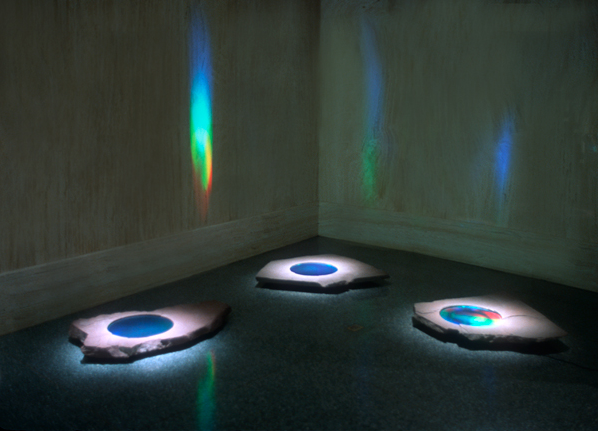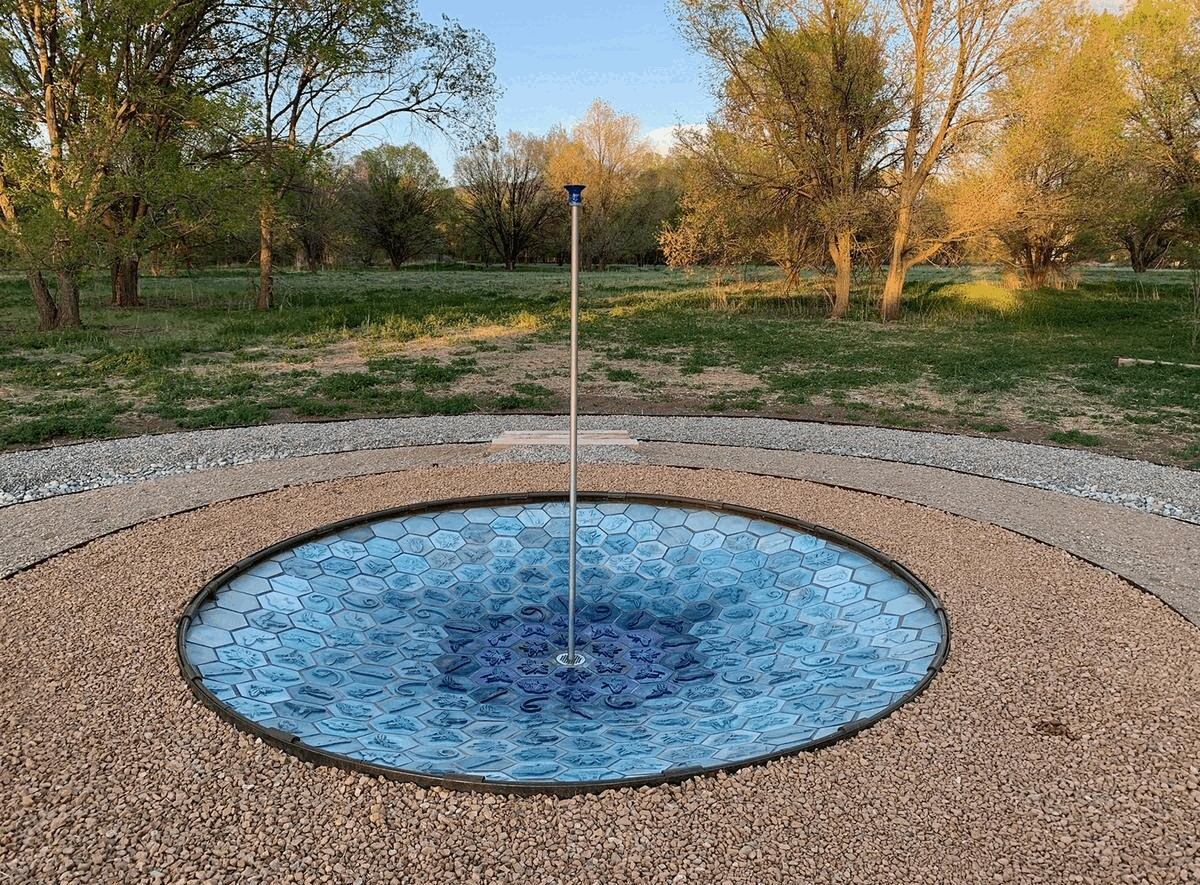
MEMBER SPOTLIGHT
January 9, 2023
This week we recognize Ana MacArthur, and her forty plus year practice, from holography to games, while examining the intersection of art and science.
Ignition, 1989, 1982(above) is one installation in a series of works resulting from research into the current state of solar technology. It is a meditation on holography and its role as a bridge to a possible future, where the ingenuity of light would be one of the keystones to environmentally sound modes of energy production. A Seed, is a five feet diameter pumice crete dish reminiscent of both a satellite parabolic and a metaté (a tool used to transform corn into flour) and holds in its center a circular dichromate hologram that slowly turns causing a transformation of colored light on a white feather suspended above. The hologram is made from an optic that bends light to a focal point out in space, and as a result, when lit, splits the white light into its spectrum. Instead of the hologram recording an object, it captures only light itself.
click images for more info

MacArthur's installation titled Necessary pupils for climate change, Variation 2, from 2008 (above), reflects on the changes in earth's atmosphere, ensuing global climate change, as a ‘veil‘, of sorts, concealing the planet. Under this veil three million species face radical change, putting us in the midst of the 6th greatest extinction cycle in the history of the planet, and due significantly to practices unleashed by the industrial revolution and our dependence on fossil fuels.
In a moment of speculation, there is a reflection on what species are nearing extinction, and, with a near-by glass book, suggestions towards the significance of protecting this library of knowledge. Appearing as pools of water in flagstone slabs on the floor, circular holograms turning by hidden motors perplex as to how they generate the ephemeral spectrum, as if slow moving search lights, they circumnavigate the room and cross over the pupils housing the biological specimens.

Where Light Meets Water; Mumuru on the Equator, T12a, 2009 (above) is an installation focused around the display of a 5 feet diameter mold of the victoria amazonica, the world’s largest water lily from the Amazon Rainforest of Brazil. As an ongoing extensive project, an initial phase involved making a successful mold of an exceptionally large water lily, on site in the Amazon. On one surrounding wall a 15 foot scroll shares stories, through photos and text, and experiences from two trips and six attempts to complete a successful mold of this unusual organism. It outlines the context of a bioregion extremely vital for what it produces biologically, yet presently under great threat via the reciprocal effects of deforestation and climate change. A small object with a dichromate hologram of a solar cell draws a report with the nearby impressions of the giant leaf and, by association, recalling leaves as the inspiration for photo-voltaic cells. A series of small shelves with translucent wax impressions of the complex, underside of the lily are backlit with a two LED colors per shelf; a representation through linear time of the most pronounced frequencies of the sun's radiation affecting the plants growth in each phase of transformation. Nearby in an enclosed room, a continuous loop video slows one into painterly, haunted sounds of the primordial edges of the Amazon.

MacArthur’s installation In Search of the Collaborative Blue Fringe, Part II,2016 (above) is focused on a collaboration with a non-human animal (butterfly) and a biologist, while reflecting on extinction, interspecies relationships, energy generation and efficiency, and collaboration as a means to unexpected solutions. The work evolves from layers of exploration and meaning of the blue diffracted light from two species of butterflies. The work engaged scanning electron microscope explorations, fieldwork collaboration with a behavioral biologist, the symbolism and psychology of the color blue, and the use of sugar as both energy source for butterflies and flow of energy through the living world.

For Pollinator Concentrator, 2019-2020 (above), located in Taos, New Mexico, the hexagon tiles and the overall pattern of tile work were inspired by the ommatidia pattern on a butterfly’s eye. As much as the tile imagery looks simplistic it was derived from exact scientific photos or specimens with the purpose to maintain the exact morphology for identification, study, and memorization through touch. Each pollinator tile species is from New Mexico, with one exception, and with representations from the main pollinator groups, bees, hummingbirds, bats, butterflies, and wasps. Particular species were chosen for ease of laser etching, resulting readability, and ease of casting. Each specific pollinator in tile has a unique story. A blue glass knob at the top of the pole, the exact mathematical 'focal point' of the parabolic tiled dish, is also a small dish to capture water for thirsty pollinators.
Hexapous, 2022 (below) is a poetic board game played to somatically integrate awareness toward protection and increased propagation of the ‘class insecta’ and more specifically pollinators. Within actions of the player, empathy increases thus clarifying human behaviors that impinge or expand the diversity of this decreasing family of partially invisible creatures; some appearing in the full light of the sun and others in its absence, at night.

Ana MacArthur’s trans-disciplinary art practice functions as a creative catalyst by revealing nature’s processes and connected metaphors through the lenses of life’s relationship to light, environmental intelligence, and appropriate technology. MacArthur’s years of art/science researched-based practice along with tactile engagement with light and environmental work has focused on biodiversity preservation via collaborating with scientists and biologists, immersion in fieldwork including in the Amazon rainforest, pioneering the field of dichromate holography, site specific projects working with community, and innovative curriculum building in biomimicry, environmental education, and STEAM with the desire to catalyze significant change. She has exhibited her art projects and lectured internationally. anamacarthur.com
Featured Images (top to bottom): ©Ana MacArthur, Ignition, Techno-Artists: New Paradigms for Virtual Reality, Metro State College of Denver, Colorado, 1989, 1992;Necessary Pupils for Climate Change Variation 2, 2008, Flagstone, 18 inches circular dichromate holograms, motors, hydrocal plaster, dcg holograms on glass, steel, halogen lights, dimensions variable; Where Light Meets Water, Mumuru on the Equator, T12a, as part of LAND/ART, Santa Fe Art Institute, Santa Fe, NM, 2009, archival pigment print scroll, 42 x 15 inches, suspended hand lenses, dichromate hologram of solar cell, paraffin wax, LED's, digital photos on translucent paper, projected DVD in dark room, 2 part 5 feet diameter mold of Victoria amazonica;In Search of the Collaborative Blue Fringe, Part II, Heizhaus, Uferstudios, Berlin, Germany, 2016, mixed media, black tent 10 feet diameter x 10 feet, video triptych, projectors, speakers, sugar crystals, sugar castings, blue trash, sugar lens, LED light, silk panels; In Search of the Collaborative Blue Fringe, video triptych dimensions variable;Pollinator Concentrator, 2019 – 2020, site-specific interspecies installation, BioSTEAM, STEMarts program for the Taos Land Trust, sited at Rio Fernando Park on Taos Pueblo indigenous land, Taos, New Mexico; Hexapous, 2022, prints of insects or pressed flora sandwiched between Plexiglas tiles, text, marbles, o-rings, cushions, 9ft diameter, sited at Poetry Garden, Santa Fe, New Mexico, ecoartspace exhibition and fundraiser; below, portrait of artist by Kristen Kuester.
